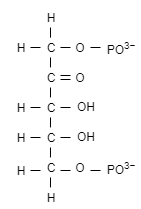This set of Cell Biology Multiple Choice Questions & Answers (MCQs) focuses on “Chloroplast Function – CO2 Fixation and Carbohydrate Synthesis in C3 Plants”.
1. Who discovered C3 cycle?
a) Melvin Calvin
b) Kolliker
c) Robert Brown
d) Rudolph Markus
View Answer
Explanation: Melvin Calvin discovered the C3 cycle, otherwise known as Calvin cycle in photosynthesis pathway of Chlorella. He used radioisotope carbon – 14 to mark the path of the metabolism in the C3 plants.
2. Identify the following compound.

a) Ru5P
b) RuBP
c) R5P
d) Rpi
View Answer
Explanation: RuBP is ribulose 1, 5-bisphosphate, a 5 carbon compound. RuBP is involved in the carbon fixation. RuBP is regenerated from Ru5P by phosphorylation and it renters the cycle through HMP shunt.
3. Which of the following is an example of C3 plants?
a) Sugarcane
b) Cactus
c) Wheat
d) Corn
View Answer
Explanation: C3 plants use RuBisCo as a reducing agent to fix atmospheric carbon dioxide. C3 plants are the most common among the plant kingdom and include plants like cereals such as barley, oats, rice and tubers like potato and sugar beet.
4. C3 plants grown in cold climates.
a) True
b) False
View Answer
Explanation: The C3 plants are most commonly found in temperate and cold regions. They can do photosynthesis efficiently in cold climates, where there is less loss of water.
5. Calvin cycle occurs in the cytoplasm of the cell.
a) True
b) False
View Answer
Explanation: Calvin cycle takes place in the stroma of the chloroplast of the cell. The stroma contains the necessary energy compounds for the preparation of carbohydrate.
6. What is the final product of the Calvin cycle?
a) Sedoheptulose
b) Erythrose
c) Glucose
d) Ribose
View Answer
Explanation: The Calvin cycle produces three carbon sugar molecules by taking 3 molecules of CO2 from the atmosphere. These three carbon sugars are later converted to six-carbon sugar called glucose.
7. How many ATP molecules are required to produce one molecule of glucose?
a) 18
b) 15
c) 12
d) 9
View Answer
Explanation: Calvin cycle uses 18 molecules of ATP and 12 molecules of NADPH to synthesize one molecule of glucose. These ATP and NADPH are produced from the light reactions of photosynthesis.
8. Which of the following enzyme is used to fix CO2 through Calvin cycle?
a) Ribose -1, 5- bisphosphate carboxylase
b) Ribulose -1, 6- bisphosphate carboxylase
c) Ribose -1, 6- bisphosphate carboxylase
d) Ribulose -1, 5- bisphosphate carboxylase
View Answer
Explanation: Ribulose -1, 5- bisphosphate carboxylase is an enzyme commonly known as RuBisCO. It aids in the fixation of CO2 by absorbing the carbon from it and converting it to carbohydrate.
9. Which redox-regulated protein controls the functioning of Calvin cycle?
a) CP4
b) CP8
c) CP12
d) CP16
View Answer
Explanation: The redox regulated protein CP12 controls the carbon fixation on Calvin cycle. It consists of 80 amino acids and it is found in most of the photosynthetic organisms.
10. How many times should the Calvin cycle happen, in order to obtain one glucose molecule?
a) 2
b) 4
c) 3
d) 6
View Answer
Explanation: The Calvin cycle needs to be repeated six times to produce one glucose molecules. Glucose being a six carbon atoms gets its carbon atoms from G3P complex. The first five G3P molecules are regenerated and only the sixth G3P molecule completes the glucose.
Sanfoundry Global Education & Learning Series – Cell Biology.
To practice all areas of Cell Biology, here is complete set of 1000+ Multiple Choice Questions and Answers.
If you find a mistake in question / option / answer, kindly take a screenshot and email to [email protected]
- Check Biotechnology Books
- Apply for Biotechnology Internship
- Check Cell Biology Books
- Practice Biotechnology MCQs
